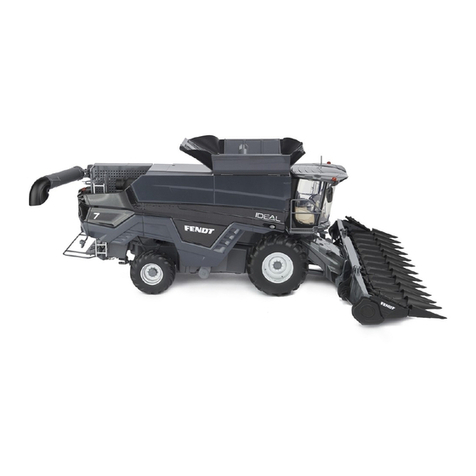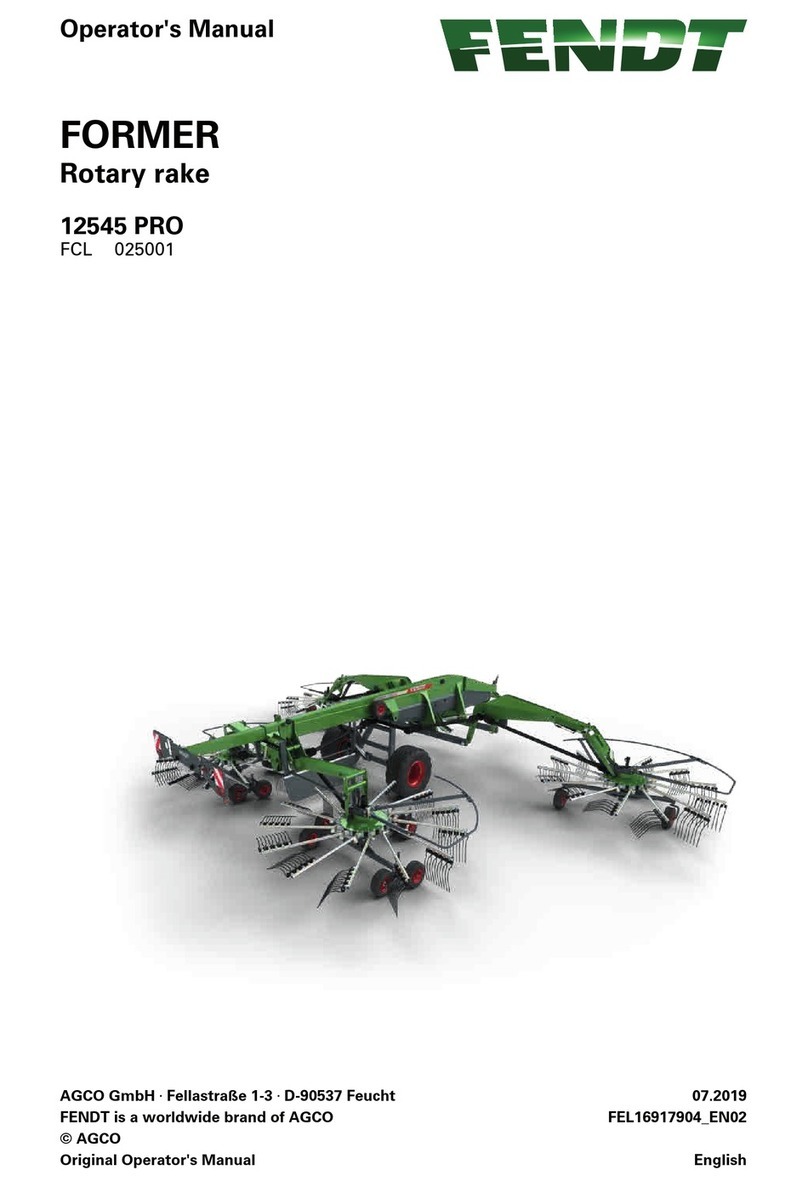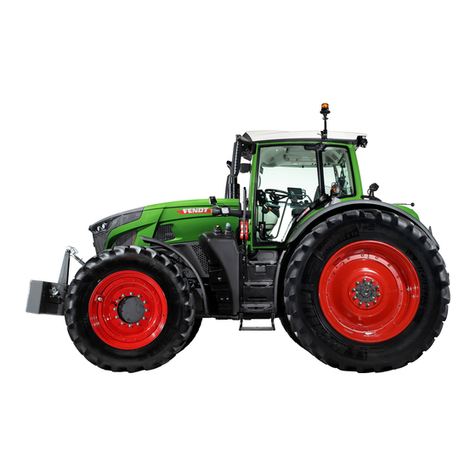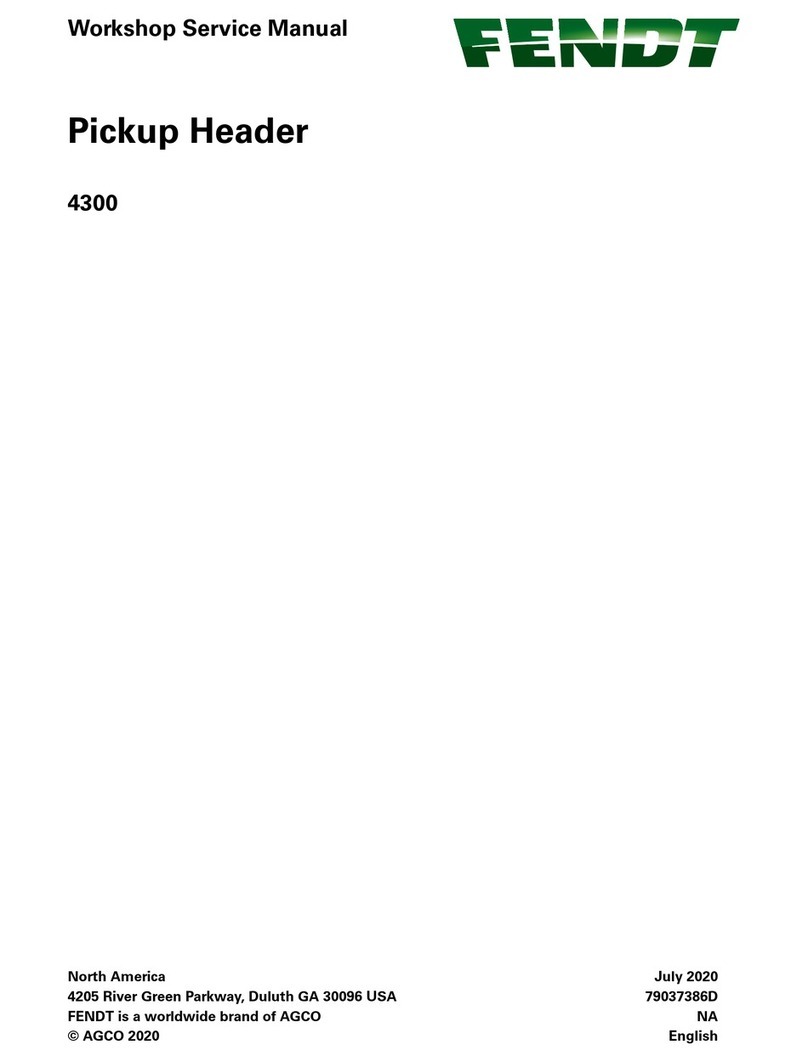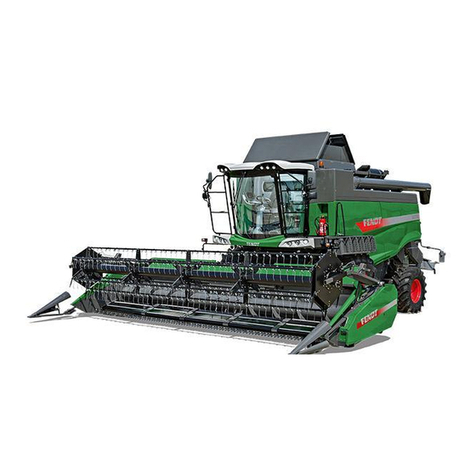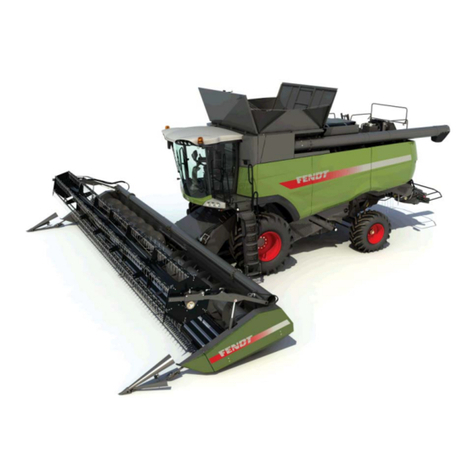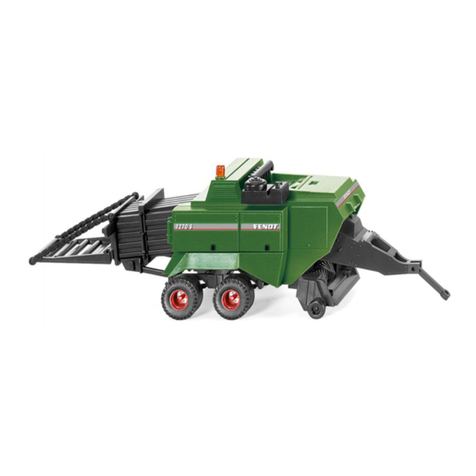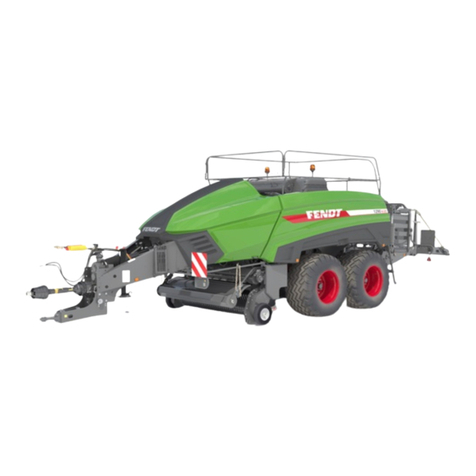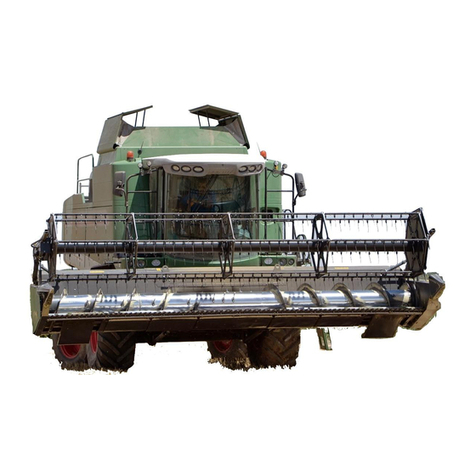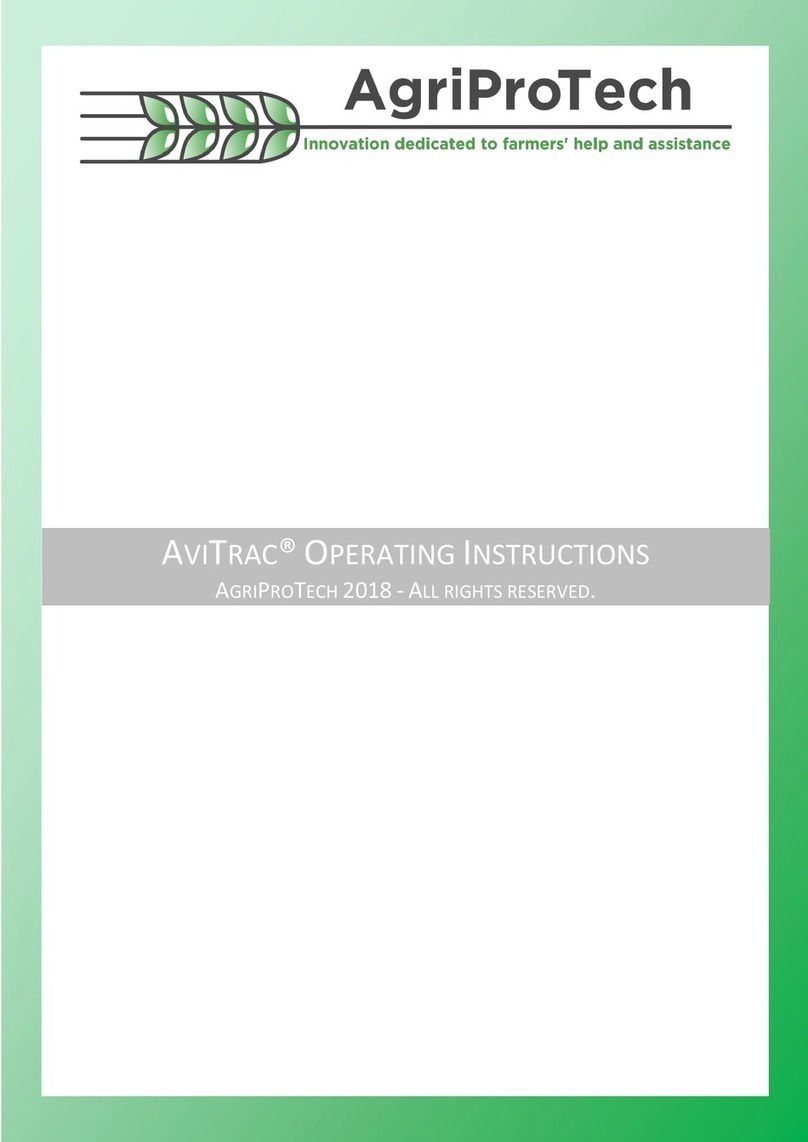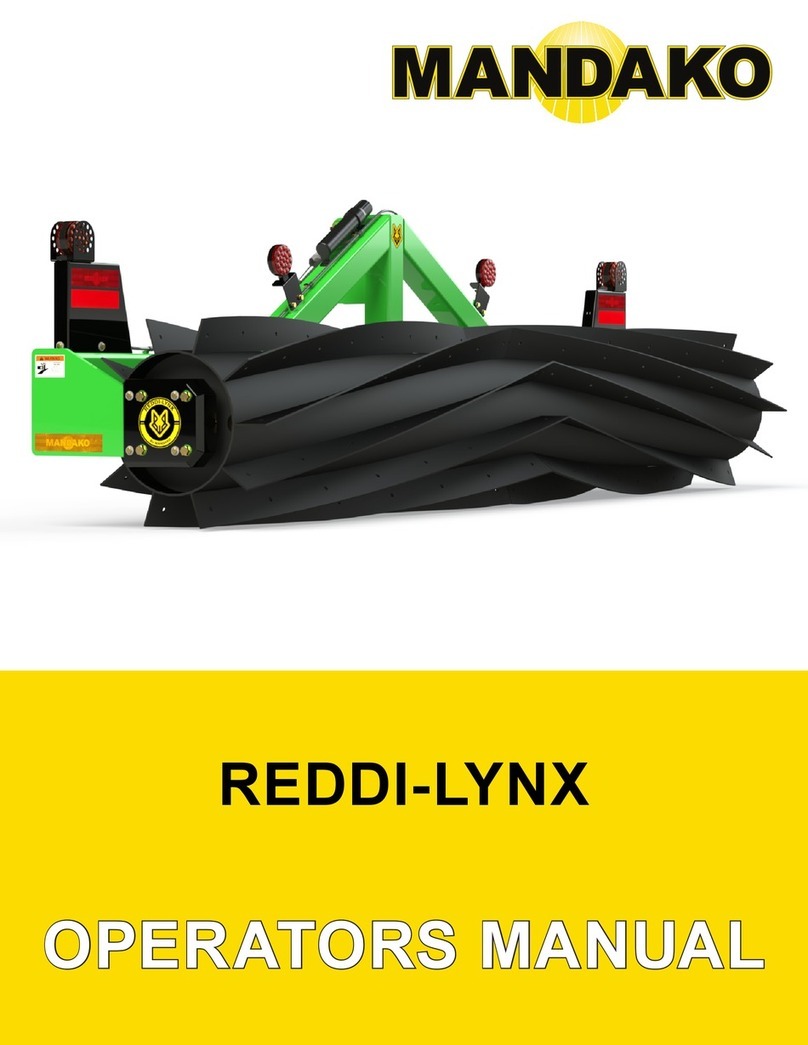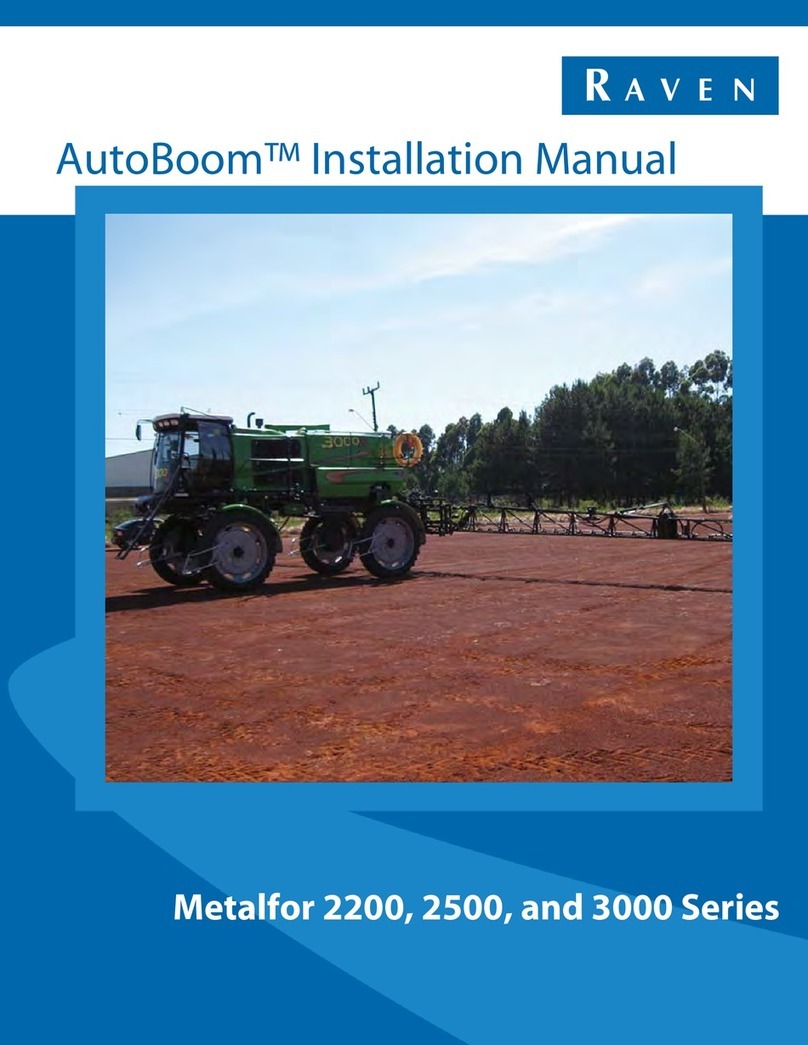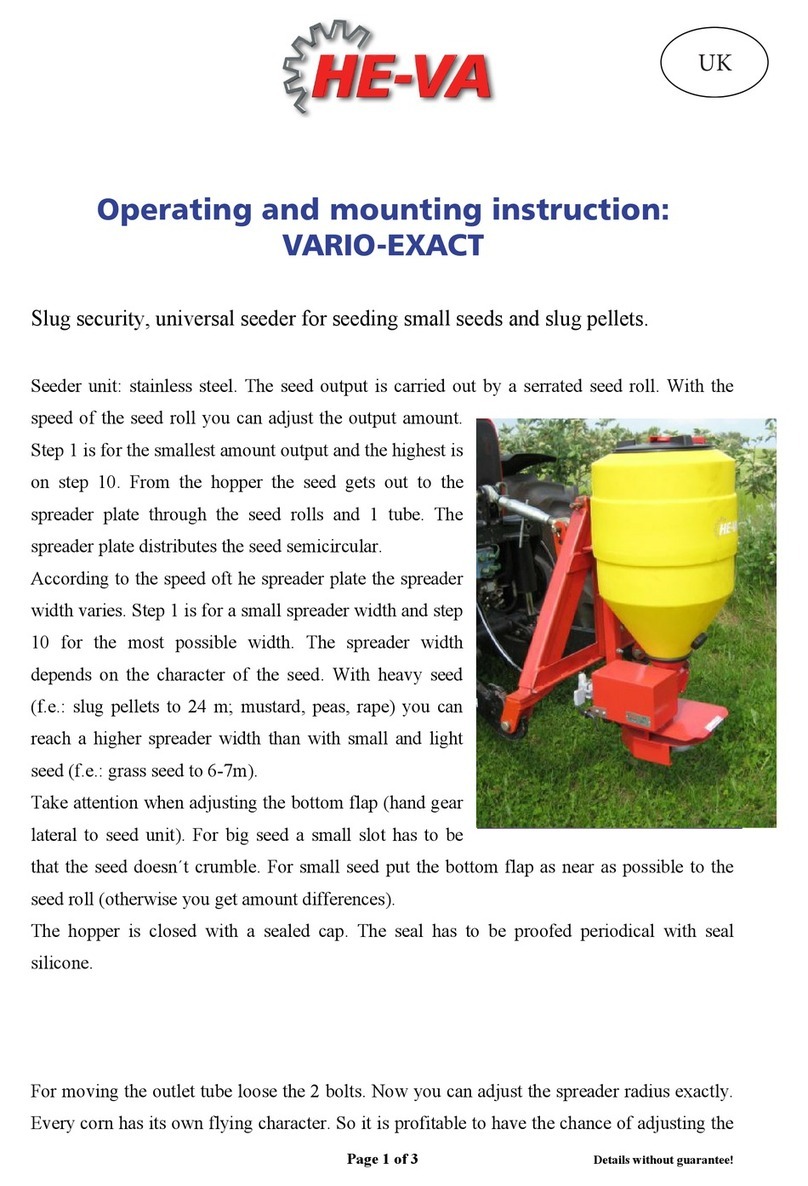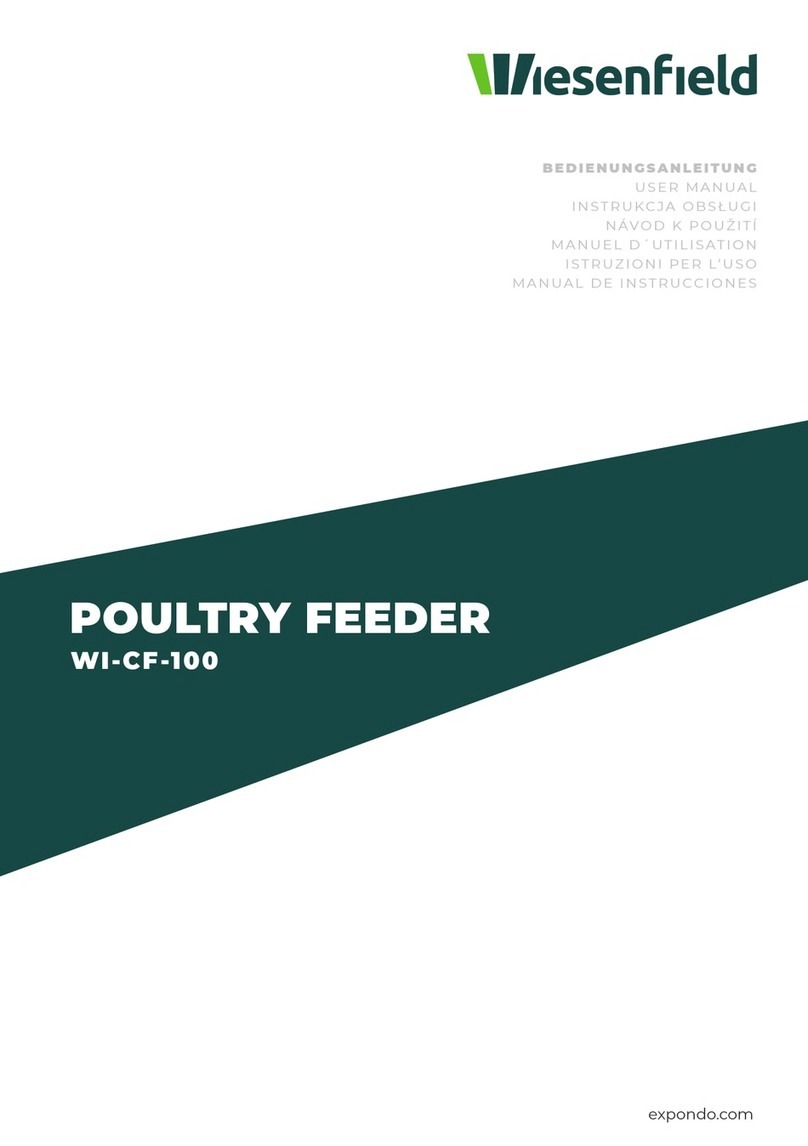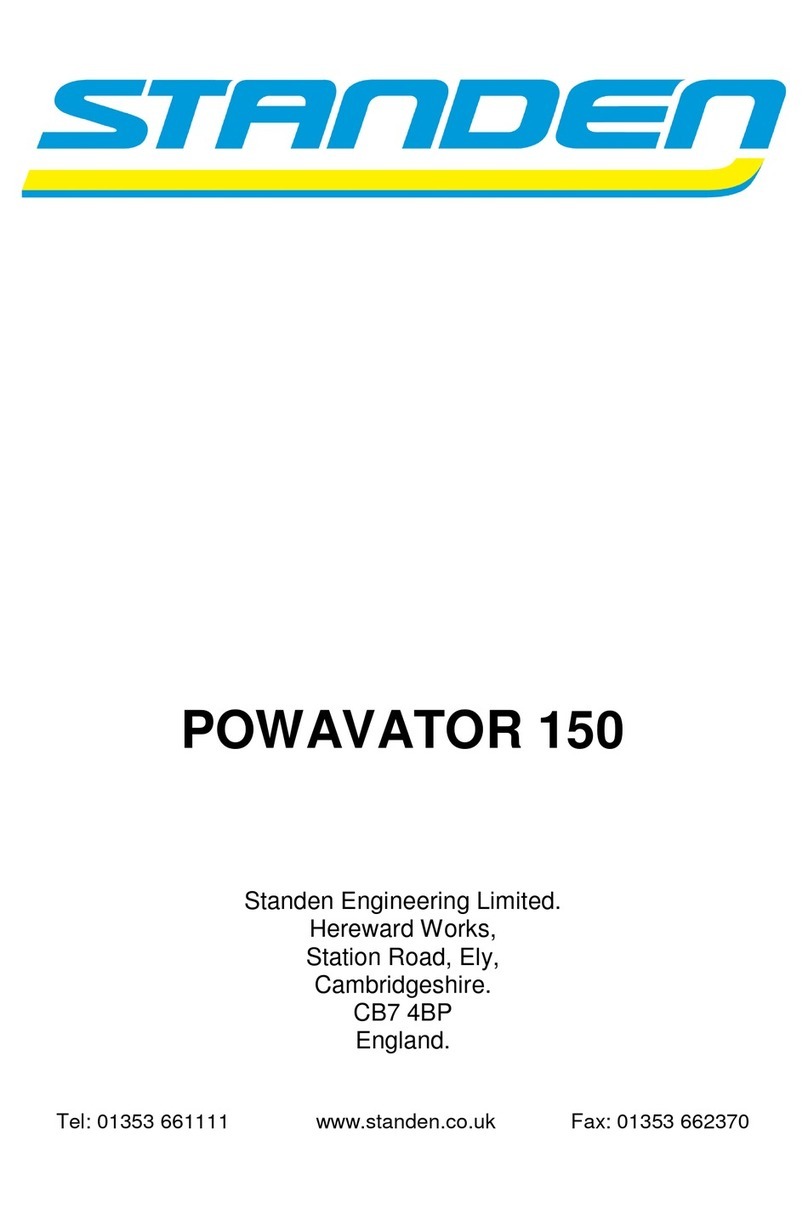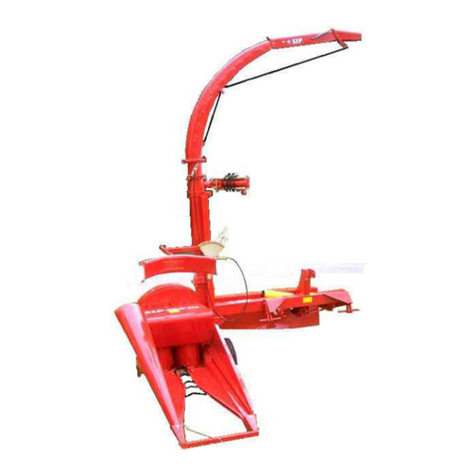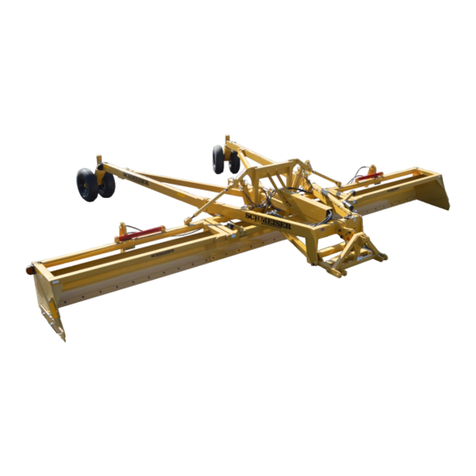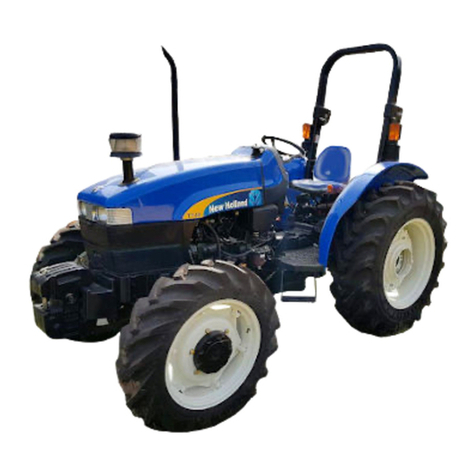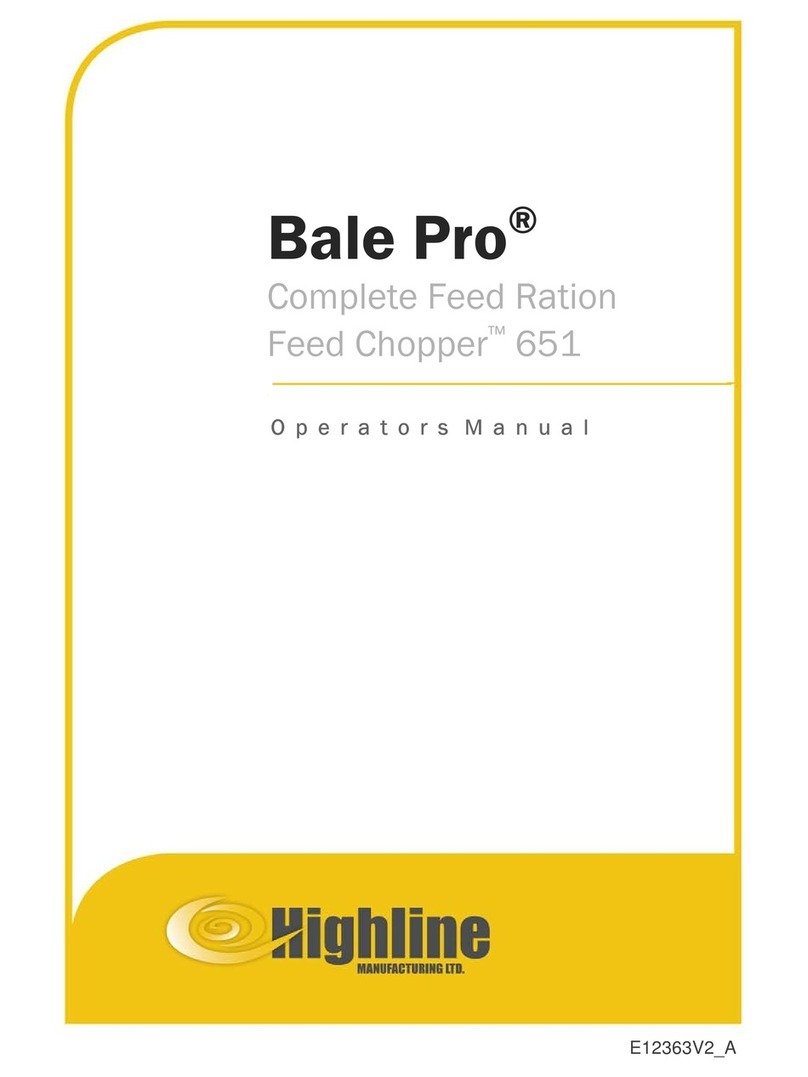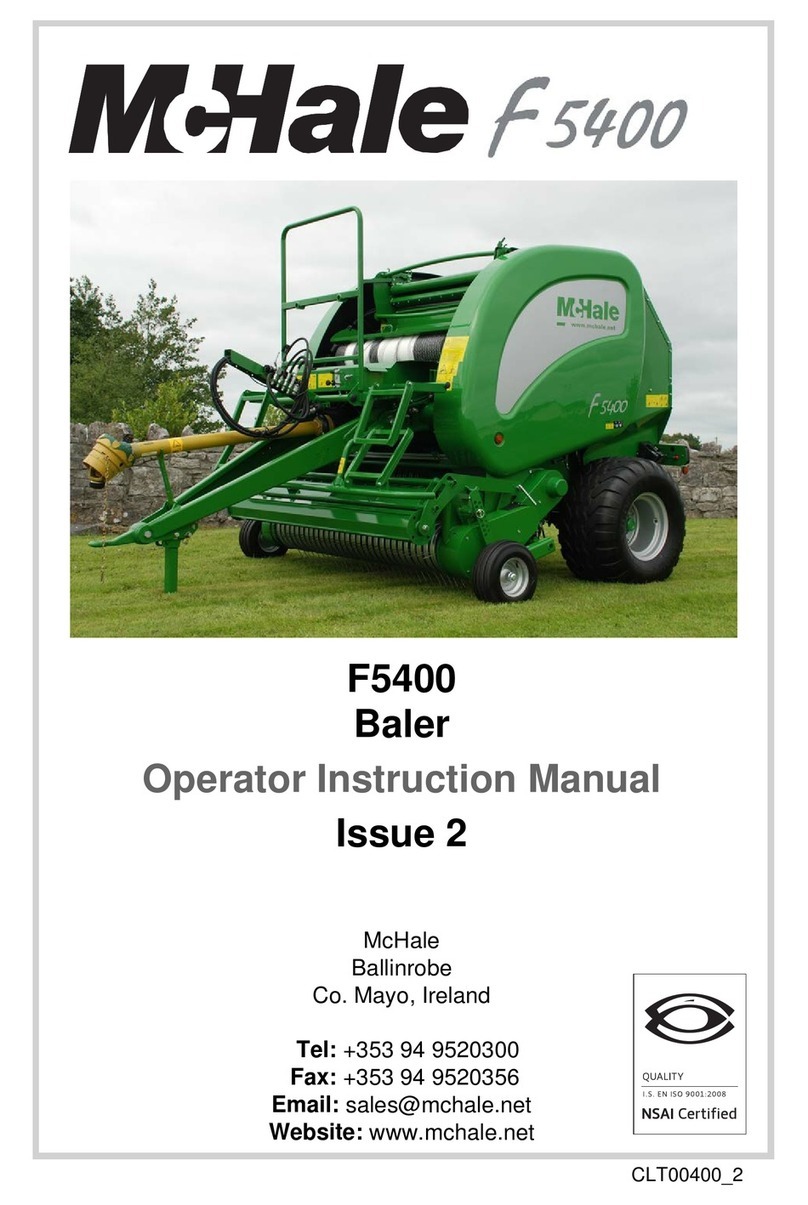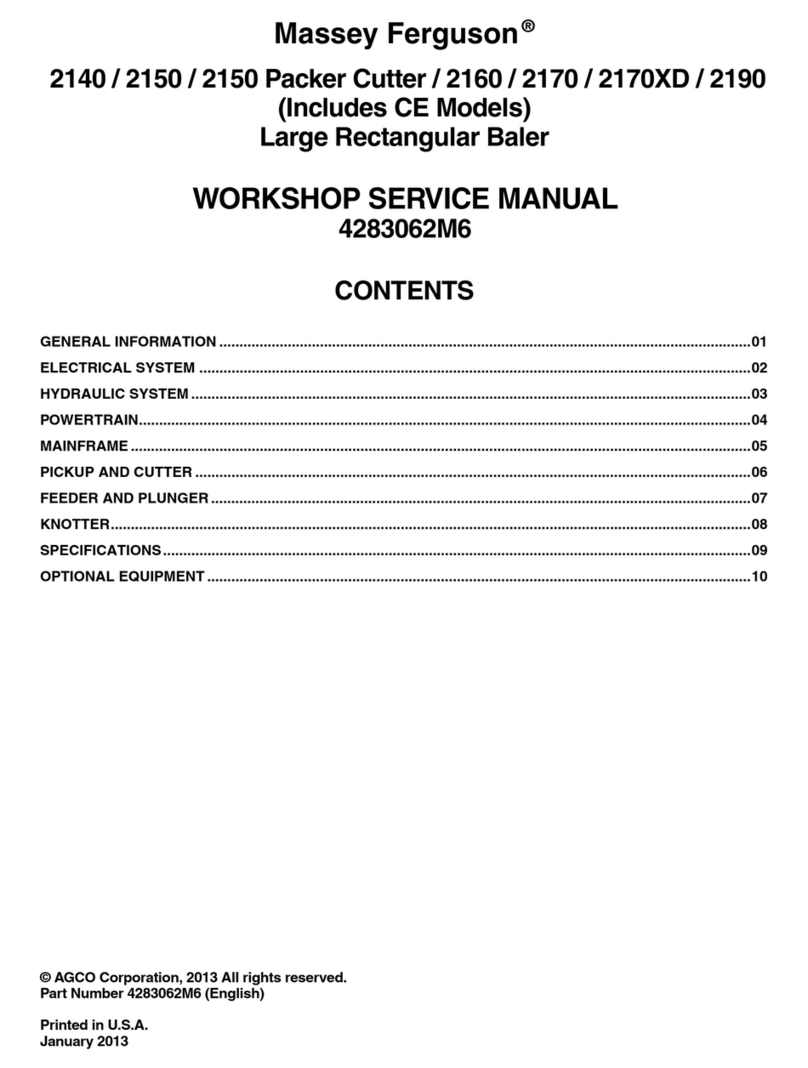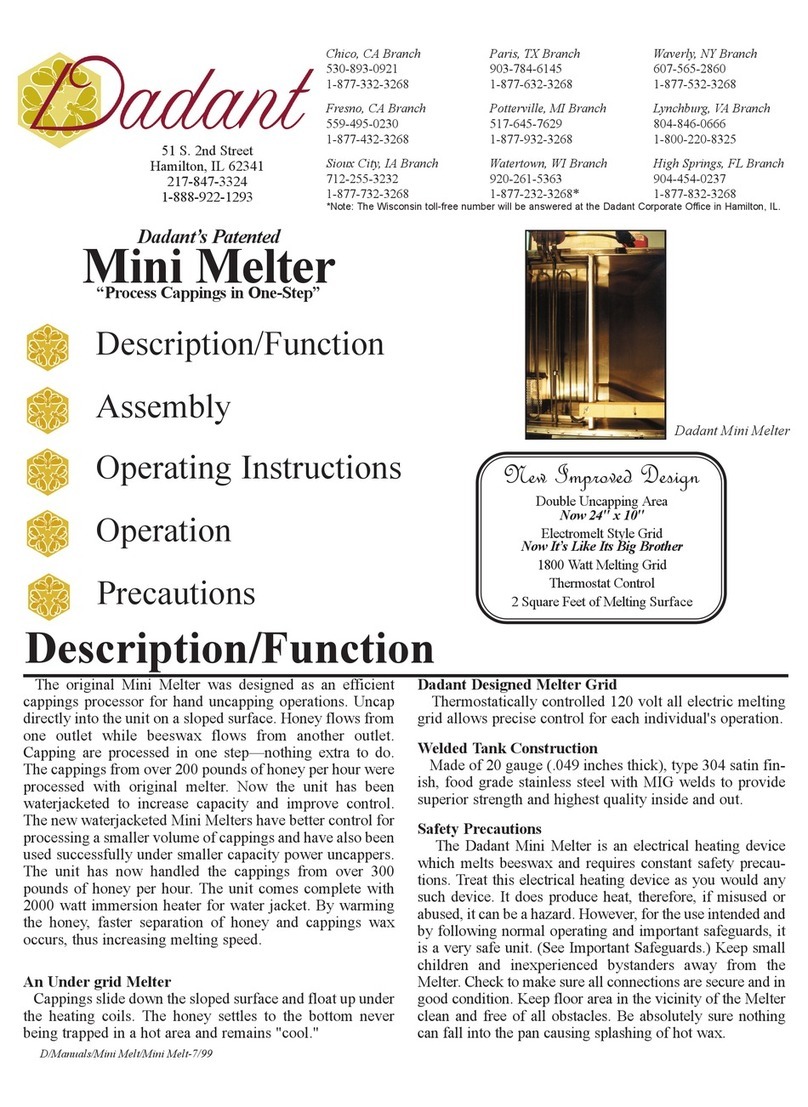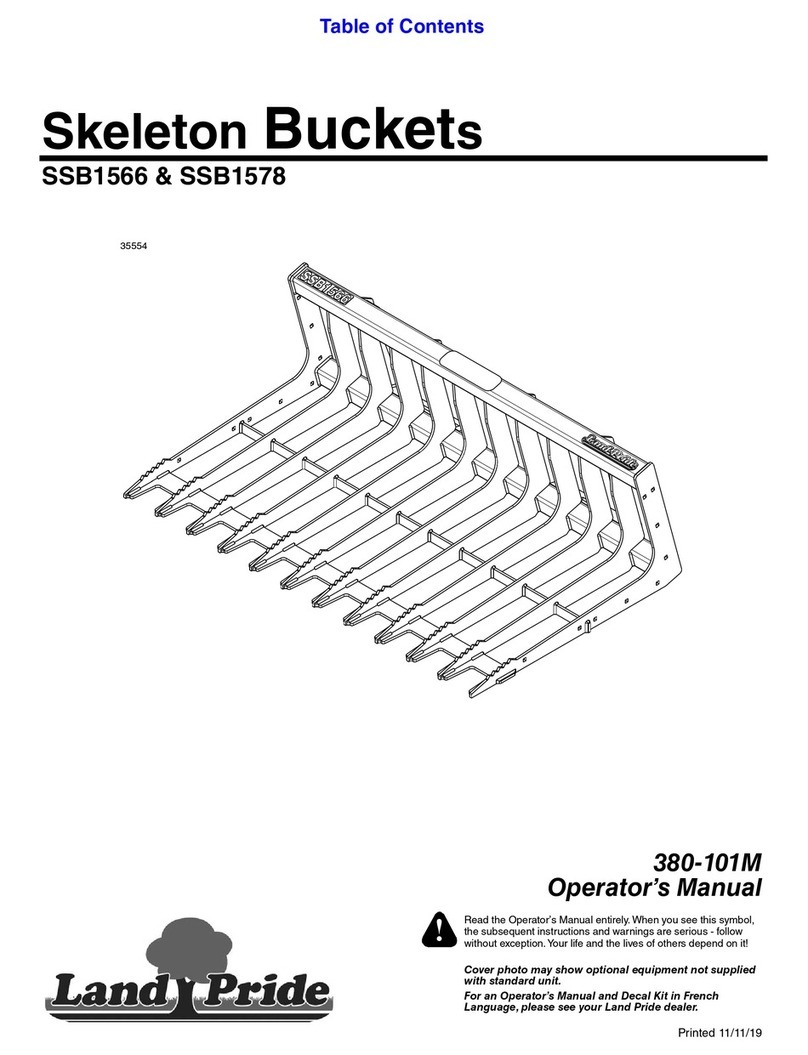FENDT IDEAL Series User manual

Operator's Manual
IDEAL Series Combine
IDEAL 7
IDEAL 7PL
IDEAL 7T
IDEAL 8
IDEAL 8PL
IDEAL 8T
IDEAL 9
IDEAL 9PL
IDEAL 9T
Breganze
AGCO S.p.A. - Via F. Laverda, 15/17 - 36042
BREGANZE (VI) – Italy.
FENDT is a worldwide brand of AGCO
© AGCO 2019
Original Operator's Manual
November 2019
ACX2738370
EME
English

Congratulations on your selection of an AGCO®Product. We believe you
have exercised excellent judgment in the purchase of your AGCO®
machine. We are most appreciative of your patronage.
Your Dealer has performed the pre-delivery service on your new
machine.
He will discuss with you the operating and maintenance instructions
given in this manual, and instruct you in the correct and varied
applications of this machine. Call on him at any time when you have a
question or need equipment related to the use of your machine.
We recommend that you carefully read this entire manual before
operating the machine. Also, time spent in becoming fully acquainted
with its performance features, adjustments, and maintenance schedules
will be repaid in a long and satisfactory life of the product.
This equipment is covered by a written warranty which will be provided
to you by your AGCO®Dealer at time of purchase.
AGCO®reserves the right to make changes or add improvements to its products at any time
without incurring any obligation to make such changes to products manufactured previously. AGCO
®, or its dealers, accept no responsibility for variations which may be evident in the actual
specifications of its products and the statements and descriptions contained in this publication.
Find manuals at https://best-manuals.com

1 Safety
1.1 Safety icons ............................................................ 21
1.2 Warnings ............................................................... 22
1.3 A word to the operator .................................................. 23
1.4 Safety instructions ...................................................... 25
1.4.1 Engine safety instructions ............................................. 25
1.5 Operation .............................................................. 26
1.5.1 Prepare for operation ................................................. 26
1.5.2 General information .................................................. 26
1.5.3 Emergency situations .................................................27
1.5.4 Personal protective equipment .......................................... 27
1.5.5 Seat safety ........................................................ 28
1.5.6 Operator not on the operator's seat ...................................... 28
1.5.7 Shields and safety guards .............................................. 28
1.5.8 Exhaust warnings ................................................... 29
1.5.9 Ejected material .....................................................29
1.5.10 Handrails .......................................................... 29
1.5.11 Header safety ...................................................... 30
1.5.12 Grain tank safety .................................................... 30
1.5.13 Cha spreader and straw chopper safety ...................................30
1.5.14 Procedure if the machine touches a high-voltage source ....................... 31
1.5.15 Drive the machine on the road .......................................... 31
1.6 Safe maintenance ....................................................... 33
1.6.1 Operator maintenance ................................................ 33
1.6.2 General maintenance information ........................................ 33
1.6.3 How to prevent fires and fire equipment ................................... 33
1.6.4 High pressure leaks .................................................. 34
1.6.5 Fuel Safety ........................................................ 34
1.6.5.1 Ultra-Low Sulfur Diesel ...................................... 35
1.6.6 Engine maintenance safety .............................................35
1.6.7 Electrical safety ..................................................... 36
1.6.8 Accumulator safety .................................................. 37
1.6.9 Tire safety ......................................................... 37
1.7 Additional safety information ............................................ 38
1.7.1 Noise emissions .................................................... 38
1.7.2 Vibrations in the cab ..................................................38
1.7.3 Electromagnetic emissions .............................................39
1.7.4 Statutory law ....................................................... 39
1.8 Safety decals ........................................................... 40
1.9 Safety devices .......................................................... 49
1.9.1 Wheel chocks ...................................................... 49
1.9.2 Emergency exit and emergency exit tool ................................... 49
1.9.3 Seat belts ......................................................... 49
1.9.4 Handrails .......................................................... 50
1.9.5 Safety stop for the header lift cylinder ..................................... 51
1.9.6 Engage the safety stop for the header lift cylinder ............................ 51
1.9.7 Disengage the header lift cylinder safety stop ............................... 52
1.9.8 Shield tool ......................................................... 53
1.9.9 Warnings for the ParaLevel system ....................................... 53
1.9.10 Reverse alarm ...................................................... 54
Table of contents
IDEAL Series Combine 19
ACX2738370
Find manuals at https://best-manuals.com

1.1 Safety icons
Safety warnings show in the manual with these icons:
DANGER:
This is an immediately hazardous situation which, if you ignore it, will cause death or
injury.
WARNING:
This is an immediately hazardous situation which, if you ignore it, can cause death or
injury.
CAUTION:
This is an immediately hazardous situation which, if you ignore it, can cause injury.
Secondary information
2 types of secondary information are shown when necessary.
IMPORTANT: This identifies special instructions or procedures which, if not followed can cause damage to
the machine, the process, or the area around the machine.
NOTE: Information to help you do the procedure, or improve your understanding.
GUID-5CB29D89-93BD-44B9-B034-8882D5B7A392 [V2]
1. Safety
IDEAL Series Combine 21
ACX2738370
Find manuals at https://best-manuals.com

1.2 Warnings
You can prevent most accidents when you obey the warnings and the safety instructions. To increase your
safety, and that of others, make sure that:
• Other personnel know that you are on the machine when all maintenance occurs.
• All personnel can see the applicable safety and maintenance instructions.
When compared to your machine, there can be some small dierences with the information in this manual.
GUID-057548B6-B2DF-4696-A55B-A71DE9806D75 [V1]
1. Safety
22 IDEAL Series Combine
ACX2738370
Find manuals at https://best-manuals.com

1.3 A word to the operator
• You must read and understand the safety
section in this operator's manual, and the
manuals for all implements, before you operate
this machine.
• The safety procedures in this manual increases
protection to all personnel in and around the
machine, while it is in operation or during
maintenance.
This safety section:
• Tells you some of the basic hazardous
situations that can occur during the usual
operation and maintenance of the machine.
• Gives you procedures that can help prevent
these hazards.
• Adds to the safety procedures in other sections
of this manual.
GUID-AC91CCF6-1FF8-4A85-97A1-2D1562806825-high.jpg [High]
Fig. 1
Precautions:
• Injury or death can occur if you do not obey these precautions.
• Other precautions can be necessary when you attach implements to the machine.
• Other precautions can be necessary when the conditions change in the work area, or area where you
do the servicing.
• The manufacturer is not liable for the machine:
- If you do not use the machine for its intended use.
- If you do not operate the machine correctly.
- If you do not do the correct inspections of the machine.
- If you do not lubricate the machine correctly.
- If you do not obey the maintenance schedule.
• It is your responsibility to obey the safety procedures when you operate, or do work on the machine.
Before you operate the machine, make sure that you have the approval to use it.
To have the approval to use this machine you must:
• Know how to use it.
• Know the safety instructions.
• Obey the applicable local laws.
There is a minimum age to operate some machines.
It is your responsibility to know these laws and obey them when you operate the machine or if a situation
occurs.
For your safety and the safety of others, obey all safety decals and notices on the machine and on all
implements.
Only use equipment or implements that have the machine manufacturer's approval.
Make sure that your machine has the correct equipment that is necessary by the local laws.
Do not use alcohol or drugs when you do work with the machine. They decrease your control of the
machine.
GUID-D6DA51A7-C1FB-4F7A-9C54-888FE0B58569 [V1]
1. Safety
IDEAL Series Combine 23
ACX2738370
Find manuals at https://best-manuals.com

1.4 Safety instructions
1.4.1 Engine safety instructions
• Make sure that all shields, guards and access doors are in the correct position and closed before you
start the engine.
• Make sure that no personnel are near the machine before you start the engine. Operate the horn 2
times before you start the engine to warn personnel.
• Before you start the engine, make sure that:
- All the controls are in the neutral position.
- The drive systems are in the disengaged position.
• If you start the engine in a closed area, make sure that there is sucient airflow.
• Start the engine from the operator seat only.
• Start the engine only with the start switch in the cab.
• If the machine is in gear, the neutral start system makes sure that the engine does not start. If you
override this system, it can cause death or injury.
• Do not connect booster cables to the starter motor terminals.
• Do not use starter fluid to start the engine. This can cause:
- Explosions
- Injury to personnel
- Damage to the machine.
• Keep away from the engine while it is in operation. Before you open the engine cover, stop the engine
and remove the ignition key.
• Do not smoke, have an open fire, or a source of ignition near the fuel system or batteries.
• Do not touch the exhaust manifold, turbocharger and the other hot parts of the engine.
• Do not operate the engine at the idle speed when it is not necessary.
• Keep the engine surfaces clean to prevent the risk of fire.
• Do not disconnect fuel pipes and hoses when the engine is ON. Stop the engine and wait 30 seconds
before you disconnect fuel pipes and hoses.
• The engine contains seals made of viton. If viton is exposed to heat above 300 °C hydrofluoric acid is
made. Put on gloves and clean the area with a alkaline fluid to prevent injury.
• Before you do welding on the machine you must disconnect the:
- Battery
- Engine electronic control unit
- Selective Catalyst Reduction (SCR) supply module.
Cleaning instructions
• To prevent damage to the machine, do not
clean these components with high pressure
fluid:
- Electrical equipment
- Fuel system
- Radiator.
• When you clean the engine, remove unwanted
areas of moisture and then operate the engine
to dry the remaining moisture.
GUID-2769EE7D-AD9B-40B1-869E-CC010E4E300E-high.jpg [High]
Fig. 2
[V]
GUID-537F9C82-FFA9-45E5-92E4-D84B547112BD [V1]
1. Safety
IDEAL Series Combine 25
ACX2738370
Find manuals at https://best-manuals.com

1.5 Operation
1.5.1 Prepare for operation
• Read and understand all the instructions in this manual before you operate, or do maintenance on the
machine.
• Make sure that you know the positions and operations of all the controls.
• Make sure that all controls are in the neutral position and that you engage the parking brake before you
start the machine.
• Make sure that no personnel are in the dangerous areas at all times. Stop the machine if it is necessary.
• Know the dimensions of the machine and have sucient available space for its operation.
• If you operate the machine in these conditions, it increases the risk of injury to personnel and damage
to the machine:
- At high speeds
- Around personnel
- Near buildings
- Near other equipment or possible blockages.
• Do not let children in or near the machine.
• Do not let persons who are not approved operate the machine.
• Do not let other personnel in, or on the machine when in operation.
• Make sure that the machine is in the correct serviceable condition.
• Obey all local laws. Make sure that the machine has the correct equipment in, or on it.
• All equipment has a limit, make sure that you know the:
- Speed limits of the machine
- Distances and limits for the brakes
- Steering sensitivity
- Steering limits
- Machine limits when on a slope
- Load limits.
1.5.2 General information
When the machine is in operation:
• Make sure that you set the machine
components to the correct position when you
operate on a slope.
• Do not get out of the machine when it is
moving.
• Know the dimensions of the machine and make
sure that sucient space is available to let the
machine operate.
• Some of the devices on the machine can make
it not stable. Be careful when you engage these
devices and operate the machine.
• Keep the header as close to the ground as
possible while you go down a slope.
• If it is necessary, put on sucient weight to
balance the machine.
• Do not do sudden movements of the controls
when the machine is at high speed or
cornering.
GUID-D5F08D55-46E8-4823-8DBF-6C78DDF4387E-high.jpg [High]
Fig. 3
[V]
GUID-714DCABF-2524-4EAD-A6EA-02C6D89E0126 [V1]
GUID-5E28E2D0-7D39-478C-BC18-E7CA125E785B [V2]
1. Safety
26 IDEAL Series Combine
ACX2738370

• Decrease the ground speed when you:
- Operate the machine on rough ground
- Turn the machine
- Operate the machine on a slope.
• Do not suddenly reverse the wheels to stop.
Do not use the machine in these conditions:
• When the maximum slope of the ground is more than the maximum slope limit of the machine.
• If the level system (if fitted) malfunctions.
• Safety devices not installed and attached correctly.
• If the tire pressures are not correct.
• If the ground is not stable or has sudden contour changes.
• The tires do not have sucient contact with the ground.
• Near to the edge of ditches or steep slopes.
• If the header or applicable devices do not have the safety lock attached.
Related Links
Drive the machine on the road page 31
1.5.3 Emergency situations
• Stop the engine in all emergency situations.
• Speak to your local emergency aid.
• Use the fire extinguisher, if it is necessary.
Regularly have an inspection by approved
personnel of the fire extinguisher for correct
operation.
GUID-FF34ACC9-D080-4CD5-9528-F426605803FF-high.jpg [High]
Fig. 4
1.5.4 Personal protective equipment
For your safety, during some operations with this
machine, you must use Personal Protective
Equipment (PPE). Obey the instructions when you
see these safety decals.
• Obey all local regulations and use Personal
Protective Equipment (PPE).
• Do not put on loose clothing or other items that
can catch in parts that move.
GUID-BAFB4DD4-D188-4F9B-A0DC-5729B133A3BA-high.jpg [High]
Fig. 5
GUID-4969F957-5C2A-44BF-8C64-1BB52B82D98F [V1]
GUID-656507EC-DA05-4DAD-905F-EB63CB69057D [V1]
1. Safety
IDEAL Series Combine 27
ACX2738370

1.5.5 Seat safety
• Put on the seat belt before you operate the
machine.
• Always use the operator's seat when the
machine is moving. Do not get out of the seat
when the machine is moving.
• Use the instructor seat only to show new
procedures to new operators, or to find a
problem.
• Do not let children use the instructor seat or be
in the cab.
• Operate the machine at slower speed and on
flat ground when the instructor seat is in use.
• Do not start, stop, or turn quickly when a
person is in the instructor seat.
• Do not let personnel use the instruction seat
when the machine is on the road.
GUID-5BA328EA-7732-4CE8-97B2-6511151E943C-high.jpg [High]
Fig. 6
Related Links
Operator's seat page 251
1.5.6 Operator not on the operator's seat
The operator must not get out of the operator's seat when the machine is in operation. If the operator does
exit the seat, the machine stops all operations.
1.5.7 Shields and safety guards
• Do not open, remove or try to access areas
behind the shields or guards when the engine
is set to ON.
• After you disengage the engine, some parts
continue to move. Wait for the parts to stop
before you open the shields or safety guards.
• After you disengage the engine, the threshing
mechanism continues to move. Wait for the
threshing mechanisms to stop before you open
the shields or safety guards.
• Make sure that all shields and safety guards are
in the correct position before you operate the
machine.
• Do not operate the machine if the shields or
safety guards are damaged. Replace damaged
shields and safety guards.
GUID-CEB32148-1F4C-457C-ADF7-595DFC51AC25-high.jpg [High]
Fig. 7
GUID-55DB7C7A-F872-4FA0-A7C4-34CDA0103004 [V1]
GUID-ABE4B547-6729-4526-9243-D23E4752A09F [V1]
GUID-E7945D3B-5C05-4080-97F6-133CF1B49364 [V2]
1. Safety
28 IDEAL Series Combine
ACX2738370

1.5.8 Exhaust warnings
• The exhaust components can become hot
when in operation. Wait for the exhaust system
to become cool before you do work on the
components near the exhaust system.
• Put on personal protective equipment to give
protection to your skin when you do work near
the exhaust system.
• Make sure there is sucient airflow when you
do work on the machine in a building. Open
doors and windows in the building when the
engine is set to ON.
• If the exhaust system is damaged, stop the
machine immediately. Do this to prevent injury
to personnel or damage to the machine.
• Only approved personnel are to do work on the
exhaust system, speak to your local dealer if
necessary.
GUID-55072A39-D882-4355-8ABA-05660F3F6EDA-high.jpg [High]
Fig. 8
1.5.9 Ejected material
• Material ejects from the machine at high
speed. The ejected materials can include:
- Crop
- Rocks
- Soil
- Wood
- Other crop material.
• The ejected material can cause damage to the
machine or injuries to the personnel near the
machine.
• Use the safety guards and shields to protect
personnel from the ejected material.
• Put on personal protective equipment if it is
necessary.
• Make sure that no personnel are near the
machine when it is in operation.
GUID-1D480E10-339B-427D-9D05-37E84CC7A29A-high.jpg [High]
Fig. 9
1.5.10 Handrails
• Make sure that you use the handrails at all
times.
• Always keep 3 points of contact when you go
up or down a ladder.
• Be careful when you are high up on the
machine, if you fall it can cause an injury.
GUID-B4BF5956-B0F7-43A5-85C1-706D96BCA02B-high.jpg [High]
Fig. 10
GUID-6D805969-1E82-4D9F-A26D-ADFE67ED1E79 [V1]
GUID-E2468D18-416D-4AA5-BAA6-DD5515E49AA4 [V1]
GUID-EC20C12A-E05F-4CE0-9228-2B8D7428C65C [V1]
1. Safety
IDEAL Series Combine 29
ACX2738370

1.5.11 Header safety
When you attach the header to the machine:
• Be careful when personnel are near the header.
It has components that turn and body parts or
clothing can easily catch.
• Do not go near the header when the engine is
ON.
• At no time are personnel to be near the header
when the machine is in operation. Stop the
machine if it is necessary.
• If the header has a blockage, use the applicable
procedures. Do not remove a blockage
manually when the engine is set to ON.
• If it is necessary to manually remove a
blockage, make sure that you:
- Park the machine on a solid level surface.
- Apply the parking brake.
- Stop the engine.
- Remove the ignition key from the machine.
- Use the wheel chocks to hold the machine.
- Put on the applicable personal protective
equipment.
- If it is necessary, get more personnel to help
with the work.
GUID-838D1642-57D1-4969-8933-DA8A34CA5586-high.jpg [High]
Fig. 11
1.5.12 Grain tank safety
• The grain tank has components that turn and
body parts or clothing can easily catch.
• Do not go into the grain tank when the engine
is set to ON.
• Do not go into the grain tank when it contains
crop.
GUID-A6399ED5-1959-49D1-8FA9-5F7C93B15623-high.jpg [High]
Fig. 12
1.5.13 Cha spreader and straw chopper safety
• There are components that turn or have sharp edges in the assembly.
• Make sure that all guards and shields are in the closed position before you operate the machine.
• Do not go near the cha spreader or the straw chopper when the machine operates.
• Stop the engine, and wait for all the components to stop moving before you do the work on the
machine.
GUID-ACC2E52F-DA6B-4412-AEE6-799DE7EDE1B3 [V1]
GUID-91D43A4B-7A6B-41D4-B925-5CFACDE1F4D2 [V1]
GUID-494D9F99-6842-4500-8BA6-BB270FE86469 [V1]
1. Safety
30 IDEAL Series Combine
ACX2738370

1.5.14 Procedure if the machine touches a high-voltage source
You must keep the machine away from
overhead power cables.
If the machine and electrical cables touch, do this
procedure:
• Disengage all the drive components.
• Stop the engine.
• Apply the parking brake.
• Make sure that you can exit the operator seat
safely and do not touch the electrical cables.
• Jump from the last step, make sure that there
is no contact between your body, ground and
machine.
• Do not touch the machine until the electrical
power is set to OFF.
• Tell personnel not to touch the machine.
• Tell the applicable local authorities to disengage
the power.
GUID-DB0A93E4-AEB5-49D5-AC5F-DD1454F1CFC6-high.jpg [High]
Fig. 13
1.5.15 Drive the machine on the road
• Before you drive, make sure that you know the
road specifications of the machine for the:
- Speed
- Brakes
- Steering
- Weight.
• Do not engage the neutral position when the
machine goes down a slope.
• Obey local laws and the machine specifications
with the speed limit.
• Know and obey all local laws that refer to this
machine on the road.
• Make sure that you set all the applicable lamps
to ON when you drive the machine. Refer to
local laws if it is necessary.
• Make sure that all the lamps and reflectors are
in the correct operation. Repair, clean or replace
if it is necessary.
• Select transport mode on the controls.
• Do not drive the machine on the road with the
header attached.
- Only drive the machine with a flip up header
if this is approved by local laws. If it is
approved, do not drive the machine at more
than 30km/h.
• Make sure that the machine's dimensions are
not more than the road limits for weight,
height, length and width.
• Look for electrical cables over the road. Change
the direction of the machine so that it does not
touch electrical cables.
GUID-657D3002-48DB-436B-9B56-D3750095397D-high.jpg [High]
Fig. 14
GUID-37F2AAFC-7DFC-42FC-82F8-48D9CD0435FE [V1]
GUID-D8FDC0CD-25E3-4B18-924F-D897E910929E [V2]
1. Safety
IDEAL Series Combine 31
ACX2738370

Related Links
Prepare the machine to drive on the road page 339
1. Safety
32 IDEAL Series Combine
ACX2738370

1.6 Safe maintenance
1.6.1 Operator maintenance
The operator can only do the machine servicing in these situations:
• They know how to do the work.
• They have all the necessary equipment to do the work.
AGCO recommend you only use AGCO parts and fluids to do servicing and maintenance on your machine.
1.6.2 General maintenance information
Before you do the maintenance or repairs:
• Park the machine on a solid level surface.
• Apply the parking brake.
• Put all controls in the neutral position.
• Stop the engine.
• Remove the ignition key from the machine.
• Use the wheel chocks to hold the machine.
• Hydraulic components that lift can fall when the
hydraulic pressure decreases. Make sure that
you use the applicable supports to prevent
component movement.
GUID-DB4C2E27-9DAC-4734-83E4-BC4BB5C26EAF-high.jpg [High]
Fig. 15
When you do the maintenance or repairs:
• Examine the machine for damage or more than usual wear.
• Know that some components can possibly move and hit personnel.
• Only use applicable lift and support equipment that has the correct approval and is specified for the
weight.
• Do not stay below the machine or components when lifted above you.
• Know the dimensions and weight of applicable components when you do the work on the machine.
• Make sure that electrical or hydraulic connections are clean before you disconnect or connect them.
• Only use applicable containers to collect the fluids, for example engine oil.
• Clean all items that spill immediately and correctly discard the unwanted materials.
• Remove all unwanted material from the work area immediately.
1.6.3 How to prevent fires and fire equipment
• The crop material is flammable. Regularly
remove the unwanted crop material from the
machine to prevent a fire.
• Use a water type fire extinguisher, A class fire
extinguisher or other water source to
extinguish a crop fire.
• Examine the components to make sure that
they do not become too hot. Listen for noises
that are not usual during operation. Unusual
noises can show that a component has wear.
Worn components can become hot and start a
fire.
GUID-8FDCA67C-244A-40BA-967B-3FA4E7667A7E-high.jpg [High]
Fig. 16
[V]
GUID-C30C0C73-EDBC-4ABC-A133-ED5D17C6A39C [V1]
GUID-A8283632-AAD9-4BAC-8C30-72F3911EFB40 [V1]
GUID-8B9D8656-A8AB-4AE5-AD08-9140D90556E1 [V1]
1. Safety
IDEAL Series Combine 33
ACX2738370

• Keep the fire extinguishers in a location that you can access easily also near where the fires can occur.
- Examine the fire extinguishers regularly, refer to the manufacturer's equipment manual.
- Make sure that the fire extinguisher is full and in a condition that operates.
• For fires of material other than crop (for example oil or electrical components), use a dry chemical fire
extinguisher of A, B or C class.
• Before you cut, weld, or grind on the machine, remove flammable materials from the machine and the
work area.
• If a fire occurs, move out of the smoke and away from the fire. Get aid from your local emergency
services.
1.6.4 High pressure leaks
• The fluid that leaks from the hydraulic system
or the fuel injection system is at a high
pressure and is not easy to see.
• If the fluid goes into the skin, you must get
medical aid immediately. If the fluid is not
removed immediately, injury or death can occur.
• Use the applicable procedures to find possible
leaks.
- Do not use your bare hand.
- Put on the correct personal protective
equipment before you look for leaks.
• Before you replace hydraulic lines:
- Remove all pressure from the system.
- Put all equipment in the maintenance
position and install the supports if it is
applicable.
- Close the applicable accumulator valves.
- Stop the engine.
GUID-CB450E2E-50DF-4D16-9E59-21C0B3E5B026-high.jpg [High]
Fig. 17
1.6.5 Fuel Safety
• Fuel is flammable.
• Always stop the engine before you put fuel in
the machine.
• Keep open flames and electrical sparks away
from the area.
• Do not smoke while you add the fuel.
• Clean the area and remove spilled fuel.
• Only use fuel from an approved fuel container.
• Make sure that a class B fire extinguisher is
available when you fill the machine with fuel.
GUID-C7F758F4-CC0C-482B-9ED5-26557B3F0262-high.jpg [High]
Fig. 18
GUID-79804E84-5AE4-43FC-871E-0632EEF914F7 [V1]
GUID-C83E73C4-4979-4F45-AEE0-E3635D592CB7 [V1]
1. Safety
34 IDEAL Series Combine
ACX2738370

1.6.5.1 Ultra-Low Sulfur Diesel
Sparks can cause a fire more easily with Ultra-Low
Sulfur Diesel (ULSD) than with other diesel types.
Equipment (for example hoses) you can use to
decrease the static ignition risk decrease in eect
with time and other conditions.
Ground the machine and bond the fuel equipment
correctly to decrease the risk of static ignition and
a fire. See the equipment manuals for the fuel
equipment for more information.
GUID-E707838B-F5D5-48F0-BF75-34B264F6453D-high.jpg [High]
Fig. 19
1.6.6 Engine maintenance safety
• Stop the engine before you do the maintenance
or repair work.
• Before you do the maintenance or repair work
on the electrical system set the battery primary
switch to OFF.
• Surfaces and components near and on the
engine are hot when the engine has operated.
• Always let the components that contain hot
fluid or gas decrease in temperature before you
touch or open them.
• Before you do work on the cooling system,
make sure that you:
- Read the manual for the correct procedure.
- Let the radiator become cool.
- Gradually open the radiator cap to release
the pressure in the system.
• Fuel, lubricants or coolant can cause injury to
your skin. Put on your personal protective
equipment if it is necessary.
• Discard all unwanted materials correctly. Make
sure that you obey all local laws when you
recycle or discard these items.
• It is necessary to replace some components
after you remove them, for example an O-ring.
Make sure that you always replace these
components and do not install them again.
• Only use the components and fluids that have
AGCO approval.
• After you do the maintenance, examine the
work to make sure that it is correct. For
example, do an inspection for leaks.
GUID-81A39ABC-001C-4617-A089-FC6F702EF934-high.jpg [High]
Fig. 20
GUID-5BBEAEAD-4451-484C-A34E-3F151A7F385D [V1]
GUID-8B2A9682-3A5D-4B82-9ADB-71E97A29CE38 [V1]
1. Safety
IDEAL Series Combine 35
ACX2738370
Other manuals for IDEAL Series
1
This manual suits for next models
9
Table of contents
Other FENDT Farm Equipment manuals



